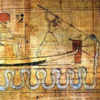Tonight is another installment of our applied theurgy classes, specifically dealing with Sutekh also known as Set.
To understand Set best for this purpose, you would need to consider him from the point of view of the teachings of heka. Heka is the Egyptian word for magick.
In Egyptian metaphysics, everything that exists shares in the essence of every other thing, so humanity exists as an emergent manifestation of the interaction of the gods or neter. Neter being the Egyptian word for god or divinity.
Set is commonly misunderstood, especially to those not having their nativity in Egyptian culture. Each deity in the Egyptian pantheon served as a patron to either a region, a class of people or both. One of Set’s own attributes was being the god of foreigners.
So to them he would be our god. Yes, but he had more influence than that. He was the god of the deep desert, the region beyond the Nile valley.
Sahara? I can’t recall the name of the desert, but I suspect you might be right. So because of his dominion over the desert away from the Nile, he was also often the god of frontier towns in the Egyptian empire and started out as the primary deity of the southern kingdom of Egypt. Like the tutelary deities of Greece, he had a special relationship with the people of his “native” region and was even seen as having been born there. His mother being the goddess Nut — for Nut read night and you won’t be far off in translation. Set was “the star child”, and had a respected place in the ship of Ra as his guardian when he came under threat from Apophis.
In what way was he a star child? The manner of his birth. He is a “star” in mother night’s sky, and was said to have fallen to earth.
The spirit of Sutekh is also associated with the role gold played in Egyptian religion. Remember there was no division between religion and culture drawn back then. It was all together just the way things were, both the law of the land and the way of nature. The reason gold was revered is that it was considered to be the essence or seed of the sun having impregnated earth so was symbolic of all growth and fertility.
Unlike the other neter or gods, Sutekh / Set is not linked to an identifiable natural animal. Instead, he is represented by the typhonic beast and like the Greek being Typhon, Set is a god of storms as well as of gold and progress and foreigners. This might be why outsiders came to associate Set with notions of an evil deity or devil.
Bear in mind even if Set were judged an evil deity, in heka his essence would still be present in humanity. Storms blew into the Nile delta from the deep desert, and well… What can you imagine would be more chaotic than a serious sandstorm?
The war between Set and Osiris is the war between the desert sands and the Nile, and the priestesses of Isis as well as Nephthys and other deities were the keepers of the knowledge that would restore and sustain life in the land of Khem.
The original name for Egypt by its natives was Khem. Thus we get the world al-chemy, which meant the science of khem, and this is also perhaps the origin of the focus on gold that alchemists pursued. Gold was the life giving principle, so what they sought was the elixir of life. The practice of medicine was considered heka. Activation of the ka is what “heka” literally means.
Your thoughts are welcome. Be well friends.
Travis Saunders
Dragon Intuitive
~science,mysticism,spirituality~



Leave a Reply